Part 3: The Kennedys Tear Down Jim Crow
John F. Kennedy “literally shook his head with incredulity” when he learned that Prince Edward County abandoned public education.
~ Brian E. Lee, A Matter of National Concern
In speaking of the years 1961-64, there can be little doubt that the major impetus for the monumental Civil Rights Act of 1964—which eliminated Jim Crow laws in the South—was President Kennedy at the White House, and Robert Kennedy and his assistant Burke Marshall at Justice. In close support was a group of individuals who—like Philip Randolph and Charles Houston—almost never get the recognition they deserve. These were the judges of the Fifth Circuit Court of Appeals. That court encompassed six former states of the Confederacy: Alabama, Mississippi, Florida, Georgia, Louisiana and Texas. They worked in concert with RFK and Marshall to overturn lower court rulings that went against the attorney general, and to cite individuals—including governors—for contempt when they disobeyed court orders. The men on that circuit are so important that at least four books have been written about them. It is a measure of the historical value of the four volumes under review that I could find no reference to that court in any of them. Yet it was their cooperation with and support of the attorney general that kept the pressure on until 1963 when the tactics of Sheriff Bull Connor ignited the issue into national consciousness in Birmingham. By that time, May of 1963, JFK already had a civil rights bill in process.
I
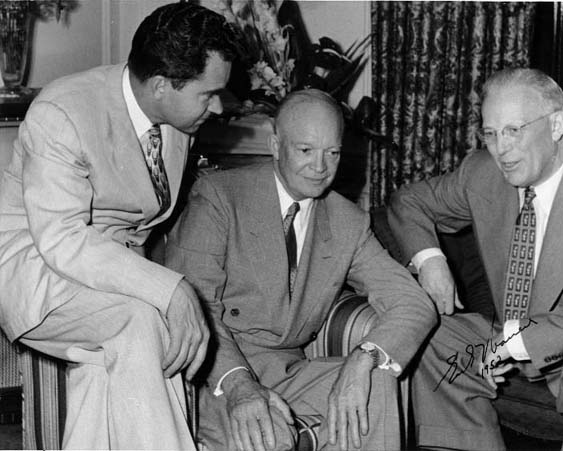 |
| Eisenhower tried to persuade Earl Warren not to decide in favor of Brown |
Harris Wofford was an assistant to the Civil Rights Commission set up by the Johnson/Eisenhower bill of 1957. As he writes in his book, Of Kennedys and Kings, President Eisenhower resisted enacting every recommendation that the commission suggested. (p. 21) As we have also seen, both Eisenhower and Nixon failed to back the Brown v Board decision of 1954. In fact, Eisenhower actually tried to discourage Chief Justice Earl Warren from deciding in favor of the plaintiffs in the Brown case. As we have seen, the only time that Eisenhower acted to apply the decision was in Little Rock, Arkansas in 1957. In that case, Eisenhower had to be asked to join the case. And he waited three weeks to send in troops to protect the students after being badgered by the mayor to do so. (Brauer, p. 4) In the Autherine Lucy case at the University of Alabama in 1956, Eisenhower failed to back the NAACP court order that allowed Lucy to continue her education in graduate school. The college and the student body literally ran her off the campus. Eisenhower did not send in marshals to escort her to class, nor did he federalize the National Guard to maintain order on campus. (Bernstein, p. 97; Jack Bass, Unlikely Heroes, p. 64)
This nod and wink by Eisenhower to the South encouraged their power brokers to find ways to dodge the court order or scheme around its objective. And this was something they were primed and ready to do. For example, in 1955, Senator James Eastland of Mississippi stated that the Brown decision wrecked the Constitution because it disregarded the law in deciding integration was right. He then closed with, “You are not required to obey any court which passes out such a ruling. In fact, you are obligated to defy it.” (Bass, p. 17) That kind of plea was made viable because Eisenhower had never stood up for the issue. For a Republican, Eisenhower had done well in the South in the 1952 election, and even better in 1956. As Charles Houston and Thurgood Marshall were closing in on Plessy v Ferguson, the Southern solution had been to build newer, nicer, separate schools for African American students. But when the Supreme Court restated the 1954 decision in 1955, it stressed that public schools should be integrated and there was no point in building new schools and arguing that these schools were equal.
As we have seen, President Kennedy was already on record as supporting the Brown decision. After he was inaugurated, there were two specific cases that Eisenhower had dawdled on which fell to him. One was in New Orleans, the other in Prince Edward County, Virginia. As we shall see, the contrast with Eisenhower—who called these issues a local problem—could not have been more dramatic. Even in 1956—after the Brown restatement—when the governor of Texas called out Texas Rangers to stop African American children from registering at court-ordered integrated Mansfield High School, Eisenhower failed to act. (Bass, p. 122)
Led by Senator Harry Byrd and columnist James Kilpatrick, Virginia was urged to abandon public education altogether. The state now passed laws decreeing any district that obeyed Brown would have funding ceased. (Nancy McLean, Democracy in Chains, p. 25) In January of 1959, higher courts overturned this action. (p. 65) The state schemed again, this time by using state vouchers for a segregated private system. This ultimately failed due to another court challenge. But in the meantime, 1,800 African American children in Prince Edward County had no schools to attend. What made this most notable was that Prince Edward was one of the five counties that Charles Houston had targeted to overturn Plessy v Ferguson. As Brian Lee wrote in his Ph. D. thesis, A Matter of National Concern, Eisenhower actually encouraged this scheme by saying that states were not required to maintain a system of public education, and therefore the president was “powerless to take any action.” (Lee, p. 50)
The Kennedys disagreed. The attorney general called Prince Edward “a blight on Virginia” and “a disgrace to our educational system and to our country”. (Lee, p. 22) President Kennedy now began to remake the 4th Circuit Court of Appeals, governing Virginia and nearby states, altering Eisenhower’s composition in order to strike down these schemes. (Lee, p. 6) In the meantime the White House did something that is probably unprecedented. While the president altered the court, the attorney general asked William Vanden Heuvel to raise money to build a free school system to educate the Prince Edward African American students left behind. Further, Burke Marshall attempted to join the NAACP legal action in Virginia, not as a friend of the court, but as a plaintiff. This had never been done by Eisenhower in six years. (Lee, pp. 145-150)
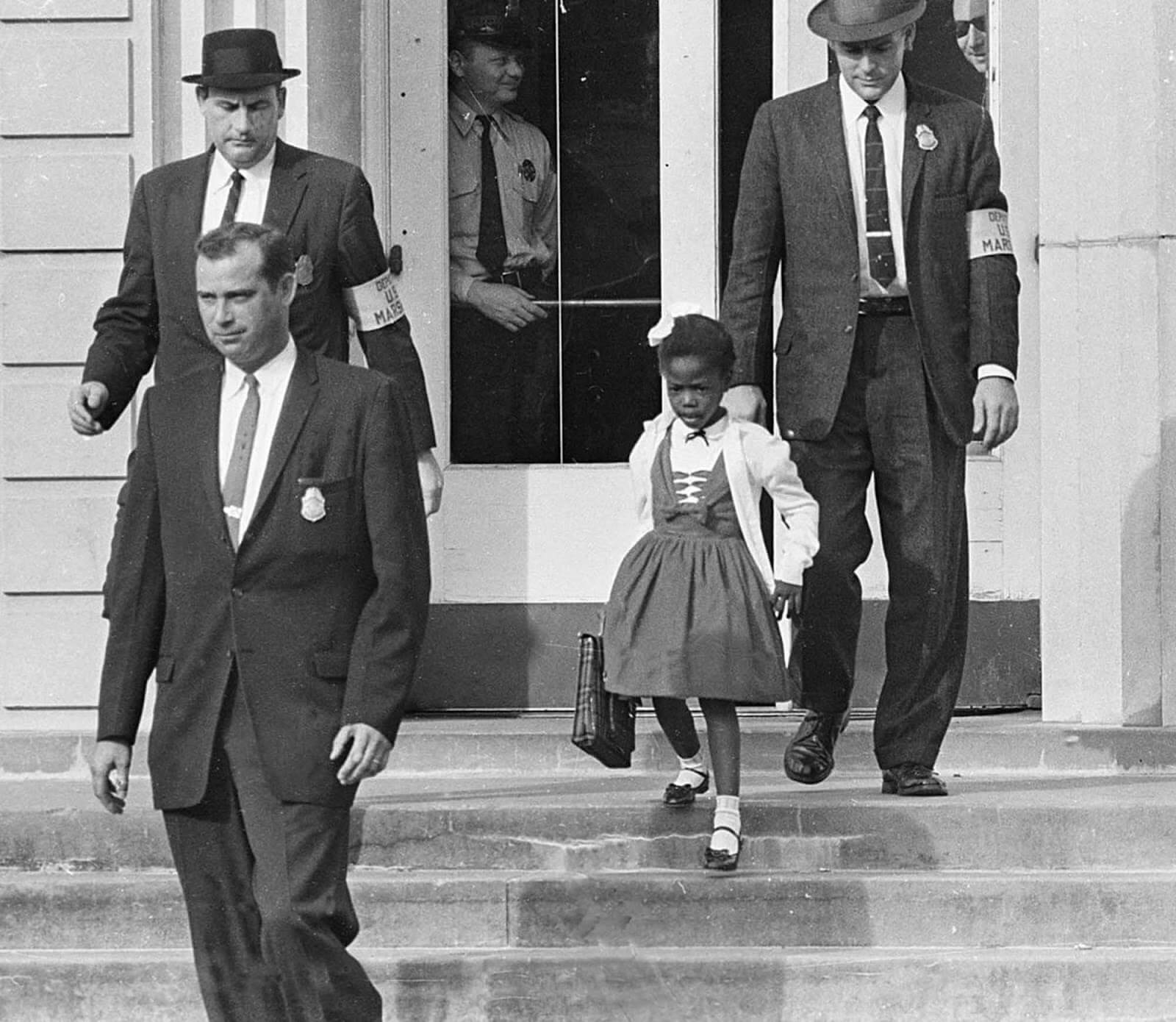 |
| New Orleans: Ruby Bridges was the only student left at the school |
This unprecedented action in Virginia was paralleled by what the administration immediately did in New Orleans. That school district, after a successful lawsuit to integrate schools, at first stalled and then schemed. Finally, federal Judge J. Skelly Wright ordered integration to proceed in September of 1960. The state legislature now passed laws circumventing Wright’s order. The Eisenhower administration asked Wright to delay issuing his new order declaring the state laws unconstitutional until after the November elections. They did not want to deal with another Little Rock. (Bass, p. 132)
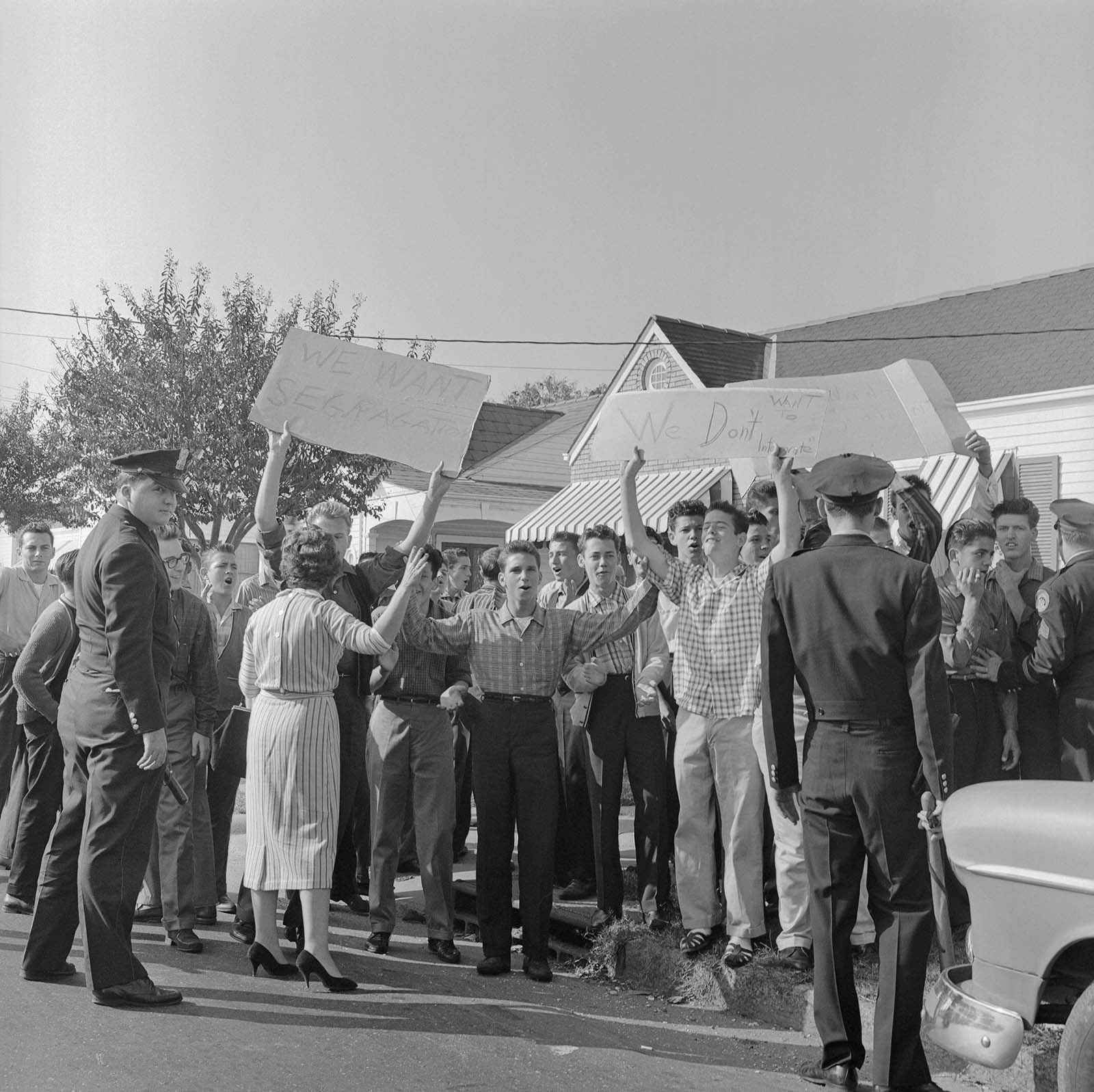 |
| Across from the school: this is what she was being protected from |
The pathology sanctioned by the White House continued. The state legislature passed laws to oust school board members and to even fire teachers who agreed to work with black students. (New Orleans Magazine, “The Struggle for Education”, January 2016) Wright again struck them down. The judge then asked for federal marshals to escort the students of color to their new schools. Louisiana now took up a scheme inspired by Orval Faubus in Arkansas. The schools ended up being largely empty, since the white students boycotted them and their parents picketed them. (Bass, p. 129)
As in Virginia, the legislature threatened to close down schools by withholding funds. Wright now called RFK’s assistant Burke Marshall. Marshall advised Bobby Kennedy of the situation. The attorney general replied, “We’ll have to do whatever is necessary.” (Bass, p. 131)
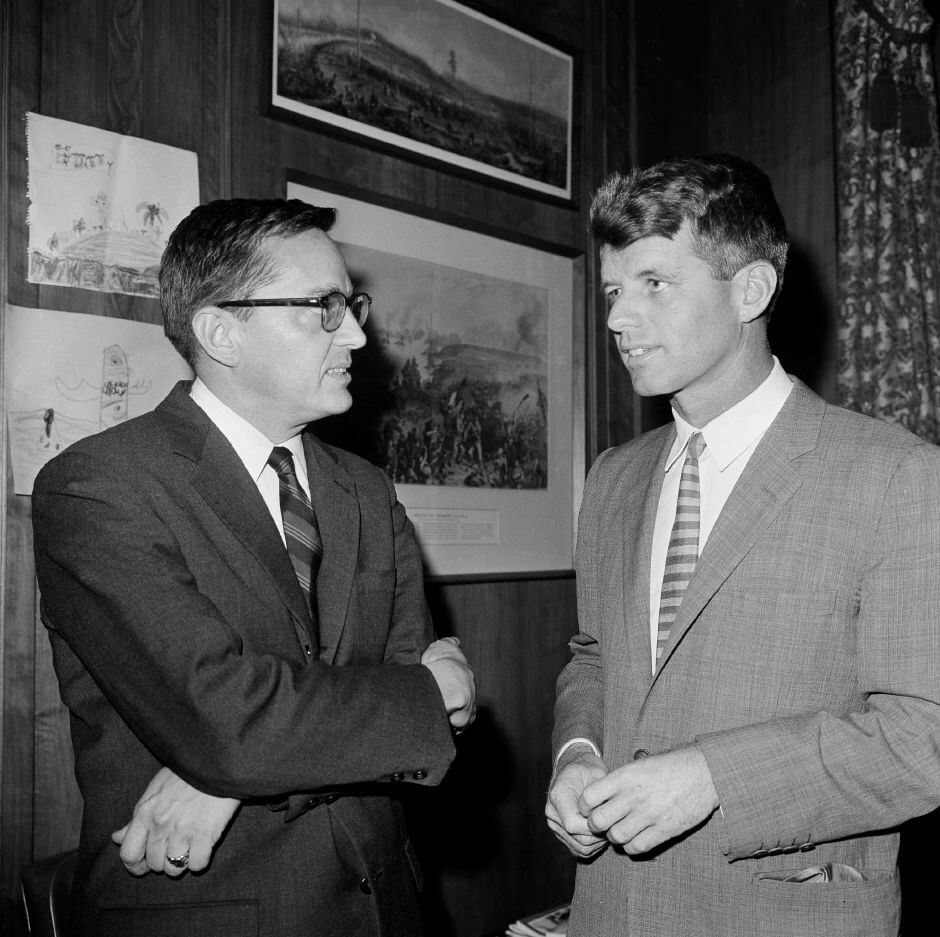 |
| Burke Marshall & RFK |
The Kennedy administration again did something unprecedented. In February of 1961, Burke Marshall filed charges against the state secretary of education, Shelby Jackson. Marshall’s aim was to block the attempt by the governor to cut off funding for integrated schools. (Bass, p. 135) Wright set a trial date to begin proceedings against the secretary for contempt of court. Jackson backed off and said he would not interfere. He avoided a prison sentence by pleading he had a weak heart.
Steven Levingston does not mention Shelby Jackson. Nor does he note the New Orleans schools case or Judge Wright. You will also not see the Prince Edward Free Schools listed in his index. But I should also note, these two cases were done without any consultation with King, though he would have endorsed them both, as other civil rights leaders did. Thus Levingston’s twin themes—that somehow King was the only focus of the race issue, and the Kennedys were denying his requests and did not understand his message—are simply not substantiated by the record. And this is in early 1961!
The administration also began to finish up Charles Houston’s work that, again, Eisenhower had abandoned. Bobby Kennedy made it a point to speak at the University of Georgia Law Day on May 6, 1961. As historian Carl Brauer wrote, this was the first time in memory that an attorney general had directly addressed the civil rights issue in the South. (Brauer, p. 95) He did this partly in order to congratulate the university for its efforts in integrating the college with relatively little violence in January of that year; partly to aid the efforts of the Fifth Circuit, for they had completed the process of integration at that university. (Bass, p. 136) In that address, the attorney general said that he planned on abiding by and enforcing the Brown decision. He spent half the speech talking about civil rights. The Kennedys would also make good on the Charles Houston goal of completing integration of higher education—a goal Eisenhower abandoned with the Lucy case—and this address was part of achieving that goal.
 |
| Senator Kennedy compared his civil rights record to Nixon’s |
In a larger sense, these were the first steps toward fulfilling a campaign promise that Senator Kennedy made on November 1, 1960 in Los Angeles. Neither Levingston nor Margolick deal with this speech, so we are left with the impression that civil rights were not an issue in that race. That is not accurate. In that speech, Senator Kennedy compared his congressional record with Richard Nixon’s on civil rights. He also compared his stand on the minimum wage, which when boosted would help many African Americans. He concluded by saying that although not everyone can have equal abilities, “everyone should have the same chance to develop their talent.” Which was something he was trying to do with education.
II
In Part 2, we discussed the Freedom Rides of May, 1961. The end result of all this was that two lawyers from the attorney general’s office filed a petition to the Interstate Commerce Commission. In the latter part of May, a request went up to issue regulations eliminating segregation at bus terminals. Under pressure from Burke Marshall, the ICC issued these in September. Marshall convinced Senator John Stennis to get the last three towns in Mississippi to remove their discriminatory signs. (Brauer, p. 109) By the end of 1962, Jim Crow was eliminated in interstate transportation. (Bernstein, p. 68)
In Wofford’s memo of December 1960, he wrote, “Ending discrimination in voting is the point of which there would be the greatest areas of agreement and the greatest progress could be made.” (Bernstein, p. 68) This was a primary goal of candidate Kennedy as opposed to Richard Nixon. In October of 1960, JFK proposed to his civil rights advisory group that they use access to voting records that the Civil Rights Commission had gained to file lawsuits in court based on voting discrimination. On the day Bobby Kennedy was confirmed as attorney general, the judiciary chairman, James Eastland of Mississippi, commented that his predecessor had never filed a civil rights case in Mississippi. This was true. It was also an understatement. During Eisenhower’s two terms, his administration had filed a total of ten civil rights lawsuits. Two of those were posted on his last day. (Golden, pp. 100, 104) The day after RFK’s confirmation, his brother sent him a note saying, “Get the road maps—and go!” Which meant: start sending your men into the backwoods of the South to secure those records and file cases.
In one year RFK doubled the amount of lawyers in the civil rights section. During that same year he doubled the amount of cases that Eisenhower had filed in two full terms. By 1963, the number of attorneys in that section had quintupled. (Golden, p. 105) RFK then hired 18 legal interns to search microfilm records in suspect districts. That opened 61 new investigations—in just a year. Prior to the Kennedy administration, it is clear that neither the Brown decision nor the strictures of the Civil Rights Commission were being obeyed. To increase the tempo, Bobby Kennedy went from suing districts to filing against a whole state, e.g., Mississippi. Although the president got regular reports on this tactic, he memorably scrawled across the bottom of the Justice Department report for 1962, “Keep pushing the cases.” (Golden, p. 111)
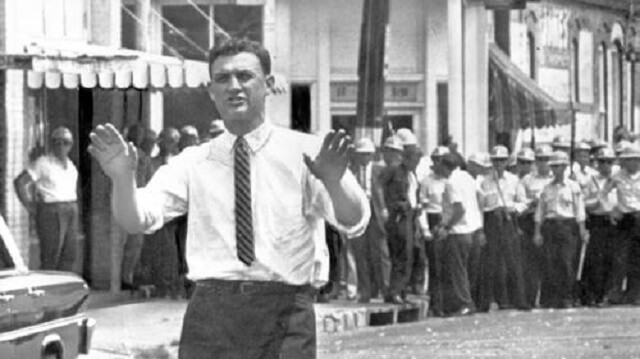 |
| John Doar |
The weight of the residue of the previous administrations was staggering. When attorney John Doar attempted to interview people in Tennessee, he found that in 13 counties, none had registered. (Bernstein, p. 68) To show just how intent southerners were to stop this effort, some of the people who talked to the Justice Department were then evicted from their lands as tenant farmers. The White House then organized an effort to send aid to those who were evicted. (Brauer, p. 72)
Useful in the voter registration regard was another mission that the Eisenhower administration never attempted. This was the voter registration drive. This presented a huge challenge. For example, in 1960, in the parish of East Carroll in northeast Louisiana, there were more African Americans of voting age than whites. But there were 2,845 whites registered to vote, and no African Americans. In the northwest parish of Bienville, almost every white voter was registered. Of the over 4,000 African Americans, only 25 were registered. (Golden, 136) The emerging problem was that these kinds of field projects are expensive, since one must send workers out with canvassing lists to knock on doors and get both information and documentation. The government itself could not supply the funds. So Marshall and Wofford went to various foundations in the north to get the money. (Bernstein, p. 72) They then parceled it out to the various civil rights groups like the NAACP, SCLC and CORE. The overall title given to the drive was the Voter Education Project (VEP). It cost $870,000, or about 7 million today. The VEP lasted until 1964. As one commentator noted, it gained an increase in its short duration that would have taken ten years to achieve under normal conditions. But more important, “It moved Negro registration off dead center, where it had been for most of the previous decade, and reestablished momentum.” (Bernstein, p. 73)
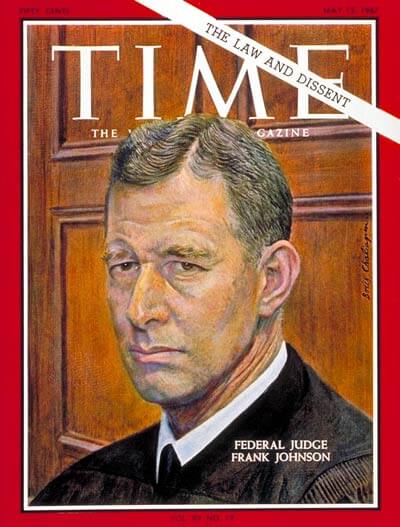 |
| Judge Frank Johnson |
In this regard, Kennedy and Marshall did something that most people would have found next to impossible. They actually got the FBI to help investigate cases of voting rights violations. This appears to be some kind of milestone for J. Edgar Hoover. (Brauer, p. 117) Extensive research in voting rights abuses were then presented to the judges of the Fifth Circuit Court. In Louisiana, with the help of Judge Minor Wisdom, the attorney general got the voting test requiring an interpretation of the Constitution thrown out in 21 parishes. That figure made up a third of the state. (Golden, p. 137) It was the Fifth Circuit’s Frank Johnson—who had worked with Robert Kennedy during the Freedom Riders crisis—who gave the attorney general his first win in a voting rights case. With Johnson’s help, the number of registered African American voters went from 13% to 42% in Macon County, Alabama. (Brauer, p. 118, 120) As Judge Johnson later said to his biographer:
The Macon County case would be the one that began to erode Southern voting discrimination … The Middle District of Alabama federal court took the lead in voting rights and the Fifth Circuit and the Supreme Court consistently upheld those rulings. When the Selma demonstrations started in 1965, the black citizens in my section of the state of Alabama had already won the right to vote. (Frank Sikora, The Judge, e-book, chapter 12)
Utilizing the Fifth Circuit, with judges like Johnson and Wisdom, plus the evolving Fourth Circuit in the upper South, and the Supreme Court sustaining their decisions, Bobby Kennedy thought he would be done securing voting rights in the South by 1968. (Golden, p. 131) The Selma demonstration, which caused the Voting Rights Act, hurried that up by three years. But as Johnson points out above, it was already happening. Clearly, this was a deliberate strategy by the attorney general. In his book on the Fifth Circuit, Jack Bass wrote that Bobby Kennedy urged civil rights groups to use the judicial process as a way to get them to their ultimate goal. (Bass, Unlikely Heroes, p. 25)
That Levingston never mentions this crucial Fifth Circuit aspect shows the worthlessness of his book. As Judge Johnson later said, no one in Washington was doing anything substantial on civil rights in the fifties, including Eisenhower. He added that when Kennedy came in, “there was almost an immediate and dramatic change. He was like electricity compared to Eisenhower … [He] put the nation on notice that there were changes that were long overdue.” (Sikora, chapter 6)
III
Related to this, the administration tried to get a voting rights bill through Congress in 1962. Eisenhower called a press conference and labeled this modest proposal for voting rights “unconstitutional”. (Brauer, p. 135) As with Johnson in 1960, there were problems with the Southern bloc in the Senate. Due to their filibuster, the effort failed. (Edwin Guthman & Jeff Shulman, eds., Robert Kennedy in His Own Words, p. 149) But this did help inspire the 1962 congressional proposal to do away with the poll tax by amendment. The 24th amendment outlawing the poll tax was ratified in January of 1964. (Brauer, p. 132)
In one of his lesser-known achievements, it was President Kennedy who began the idea of affirmative action. And it started on inauguration day. Kennedy noticed that, during the parade, there were no black faces in the Coast Guard detachment. That night he called Treasury Secretary Douglas Dillon and asked that something be done about it. (Bernstein, p. 52) Two days after Kennedy’s phone call, the academy began an all-out effort to recruit African Americans. One year later, the streak was broken and an African American student entered the academy. (Bernstein, p. 52) In 1963, the Coast Guard made it a point to visit 199 high schools, addressing 11,000 students and then interviewing 561 African American candidates. (Golden, p. 114)
That was just the beginning. At his first cabinet meeting, Kennedy brought up the incident and told each member that he wanted the figures on the racial balance in his respective department. He did not like the results. For instance: at the Department of Justice, only 19 of nearly 1700 lawyers were African American. Kennedy also discovered that most of the people of color were at the lower rungs of the hierarchy. The president now told everyone that he wanted the situation remedied and he also wanted regular reports on their progress. (Bernstein, p. 53) Kennedy got so involved in the process that his administration became the first to appoint an African American ambassador, Clifton Wharton, to a European country. As Roy Wilkins later said, “Kennedy was so hot on the Department heads … that everyone was scrambling around trying to find himself a Negro in order to keep the president off his neck.” (Bernstein, p. 53) In fact, Kennedy assigned a civil rights officer to manage hiring and complaints for each department. He then advised the Civil Service Commission to begin a recruiting program to target historically black colleges and universities. (Brauer, p. 72, 84)
The president then set up two interagency groups in order to monitor and push the issue forward. One was headed by Harris Wofford and it oversaw the entire federal government; Fred Dutton’s concentrated on the cabinet positions. On March 6, 1961—45 days after his inauguration—Kennedy issued an executive order outlawing discrimination in the workplace and making sure that affirmative action employment practices were followed.
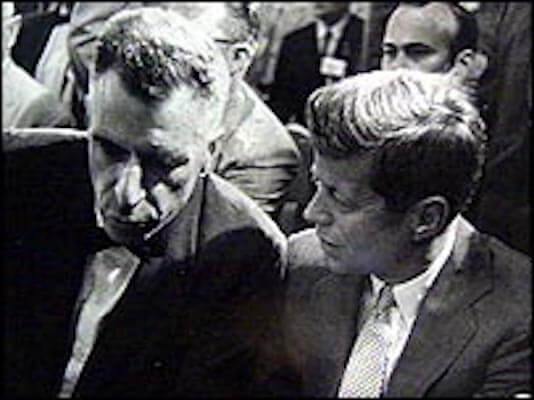 |
| Galbraith & JFK |
This concept of seeking out qualified people of color to serve in the government was complemented by another action. Together with his longtime friend, John Kenneth Galbraith, Kennedy decided to protest the color barrier at two posh clubs in the Washington, DC area, namely the Metropolitan and Cosmos clubs. (Richard Parker, John Kenneth Galbraith, p. 387) At the Metropolitan, Galbraith sponsored Kennedy as a member. But Kennedy refused to join when they declined service to a visiting African diplomat. At the Cosmos Club, Kennedy withdrew his application when the club refused to admit federal employee Carl Rowan. Kennedy got other government members and friends to follow suit and resign membership. Due to the bad publicity, both clubs later reversed policy. The notable thing about these episodes is that both were private clubs. (Washington Daily News, January 15, 1962, p, 21; Wofford, pp. 149-50) Kennedy then announced that neither he nor any member of his administration would attend functions at segregated facilities. (Bernstein, p. 53) To top it off, some of the members who resigned in protest then banded together to form a non-discriminatory club called the Federal City Club. (Brauer, p. 70)
But Kennedy wanted to go beyond just the direct reach of government employment and the upper classes of Washington, DC. As noted previously, President Truman could not sustain the Fair Employment Practices Committee that Philip Randolph had pressed on Franklin Roosevelt. So first Truman, and then Eisenhower, set up advisory committees on the issue. The aim was to make the companies that won federal contracts adhere to non-discriminatory employment practices. In reality, if, say, the army contracted out to a textile company to manufacture rolls of cloth to make uniforms, that company would have to show that it hired some people of color. Kennedy established the Committee on Equal Employment Opportunity (CEEO) as part of his March 6, 1961 Executive Order on affirmative action. (Golden, p. 59)
Under Eisenhower, Nixon had run their employment program, so President Kennedy put Lyndon Johnson in charge of the CEEO. Again, the contrast in activity is startling. In seven years, Nixon filed six suits. In a bit over two years, the CEEO heard almost four times as many complaints—1700—as Eisenhower and Nixon did in seven years, and acted favorably on over 70% of them. For example, there was a desegregation lawsuit filed against Socony in Texas. (Golden, p. 60; Bernstein, p. 59) Kennedy’s plans for retaliatory action went beyond Eisenhower and Truman. The CEEO allowed for the publication of the names of those who were violators, lawsuits by the attorney general, cancellation of the contract, and the foreclosure of future contracts. (Bernstein, p. 56) As a result, by 1963, you had people of color working alongside whites in the carding rooms of textile mills in the South. As a mill supervisor explained, “We work together for the simple reason we must if we want the government contracts. Without those contracts, we close down.” (Golden, p. 61) Its greatest achievement under Johnson was a settlement with Lockheed to integrate all of its facilities and begin a program of affirmative action in hiring. This was important since Lockheed was a large employer in Georgia. (Bernstein, p. 58)
Kennedy’s stricter program also extended to funds given to institutions of higher learning. As Melissa Kean noted in her 2008 book:
With the election of John F. Kennedy, the reach of federal nondiscrimination requirements in contracting finally extended into the admissions policies of private southern universities. Failure to comply meant ineligibility for the federal grants and contracts that were the life-blood of the advanced programs at these schools. (Kean, Desegregating Private Higher Education in the South, p. 237)
As a result of Kennedy’s more rigorous policies, large private universities like Duke and Tulane chose to quietly and peacefully admit African Americans.
The CEEO also developed a parallel program for non-discrimination in labor unions. This was called the Programs for Fair Practices. The AFL-CIO, covering about 11 million members, chartered it. (Bernstein, p. 60)
Since Johnson ran the program, the sternest critic of the CEEO was Robert Kennedy. He thought Johnson was not aggressive enough. For instance, RFK filed a lawsuit in December of 1961 against hospitals who received federal funds but discriminated against doctors or patients. (Golden, p. 113) President Kennedy felt so strongly about this issue that in June of 1963 he issued another executive order that both strengthened and extended the mandate of the CEEO. This agency later became a permanent part of the government and was renamed the Equal Employment Opportunity Commission. Kennedy had achieved what Truman could not and what Eisenhower and Nixon simply were not interested in.
IV
At this point we should address an issue that some professional writers on the Left, like Paul Street, have brought up: the idea of federal protection for those struggling for rights. This was obviously an issue in the 1963 RFK/Marshall meeting with James Baldwin and Jerome Smith. In addition to the violence during the Freedom Riders demonstrations, there was also the riot at Ole Miss in 1962, which we shall discuss, and the nationally televised tactics used by Sheriff Bull Connor in 1963 at Birmingham which Baldwin mentioned in one of his telegrams to Robert Kennedy before the meeting. (Dyson, p. 25) As Robert Kennedy later said, in addition to Jerome Smith throwing the meeting off subject, the other problem was how little Baldwin and the others knew what the law was. (Guthman and Schulman, pp. 224-25)
Burke Marshall had studied this entire field and examined the legislation that was on the books and how it fit into the system of federalism. In 1964, he wrote a brief book on the subject called Federalism and Civil Rights. To indicate his quality of scholarship, Michael Eric Dyson never mentions it anywhere in his book. Neither does Levingston. Professional historians Arthur Schlesinger and Carl Brauer do more than mention it: they spend several pages explaining Marshall’s book.
No one can deny that the Birmingham images of youngsters being attacked by rabid dogs and bounced around by fire hoses were shocking to behold. Yet no one can deny that RFK and Marshall were on the protesters’ side. So the question then became: Why didn’t they do anything to preempt it?
The answer that Marshall got sick and tired of giving was simple: America does not have a national police force. The police function is a local function. With very rare exceptions, the FBI is an investigative force, one that is supposed to help and support local and state police. Marshall then added, “There is no substitute under the federal system for the failure of the local law enforcement responsibility.” (Letter from Marshall to R. H .Barrett, 1/3/64) None other than Thurgood Marshall backed him in that judgment. The man who argued Brown v Board said that the police authority does not lie with the federal government, but within the states. That was a point that he, as a civil rights lawyer, could understand, “but the average layman cannot understand it.” (Schlesinger, Robert Kennedy and His Times, p. 318)
What both men were saying amounts to this: Robert Kennedy could not go in and arrest Bull Connor and the entire Birmingham police force. There simply was no federal mechanism that allowed him to do so. But beyond that problem, there was also the matter that, before the Civil Rights Act of 1964 was passed, Connor was abiding by the state and local laws. In that regard, we must recall Part 1 of this series, where the author explained how the Supreme Court had neutered the Reconstruction laws and amendments. In addition to that, each locality has municipal laws guiding the administration of demonstrations. Fred Shuttlesworth, father of the Birmingham demonstrations, knew he was violating them. That was his point: to use civil disobedience and moral suasion to defeat misguided power.
There was an exception in the law. And this allowed the White House ultimately to send in federal marshals and troops to Oxford, Mississippi and also to Alabama during the Freedom Rides. Sections 332-334 of Title 10 of the US Code allows the president to send in troops in instances of a large scale failure of law and order. Burke Marshall was hesitant to use Title 10. As the famous legal scholar Alexander Bickel once wrote, “As a regular and more or less permanent device, it is something from which we recoil, deeming it destructive of a free society.” John Doar also found that route to be a dangerous one: the federal government should not be a police state. (Schlesinger, p. 318-319)
A good point of comparison would be the famous incident when Robert Kennedy heard that local police had arrested a Chicano demonstrator in Delano, California before he broke any laws. This was during the time that Cesar Chavez was trying to organize fruit pickers in the central valley area. Kennedy had flown there for a hearing on their organizational rights. When he heard that, RFK advised the police officer to read the Constitution during the lunch break. (Schlesinger, p. 826) As Attorney General Kennedy had said to Anthony Lewis, the investment of dictatorial powers in the executive branch might seem convenient or expedient during times of stress. But it should be resisted, since it would boomerang later. (Schlesinger, pp. 319-20)
Today, living in the shadow of Dick Cheney, water boarding, drones, Edward Snowden and Guantanamo, I think we all understand what the attorney general meant. But the meeting with Baldwin and Smith was not the most appropriate time for Burke Marshall to take out a chalkboard and play law professor.
V
In addition to attempting to pass a voting rights act in 1962, the Kennedy administration was also working with the NAACP and the Fifth Circuit to complete the integration of colleges and universities in the South. As noted above, President Kennedy used restrictions on grants to private universities to shoehorn integration. With public universities, Burke Marshall decided to work with the NAACP to attain court orders from the Fifth Circuit. In 1963, Clemson and South Carolina integrated peacefully. Such was not the case with Ole Miss and Alabama.
The day after JFK was inaugurated, James Meredith decided to become the first African American student at Oxford. Both the NAACP and Burke Marshall decided to take part in his attempt. (Brauer, pp. 180-81) Governor Ross Barnett now invoked a policy that southern universities had used many times before. He offered to pay for Meredith to go elsewhere. When that did not work, he started shouting “states rights” and John Calhoun’s specious claims about interposition.
Robert Kennedy formally entered the Justice Department into the legal proceedings. President Kennedy began to lobby business leaders in the state. (Brauer, pp. 182-83) When the university tried to deny Meredith’s application, the Fifth Circuit, in an opinion written by Minor Wisdom, overruled the denial. (Bernstein, p. 77)
But now, the trustees of the college transferred power over to Barnett. The Fifth Circuit first charged the trustees, then Barnett, with contempt. (Brauer, p. 184) At Millington air base in Memphis, the president now began to build up a force of federal marshals and draw up a military contingency plan which would eventually include 20,000 troops. (Bernstein, p. 81)
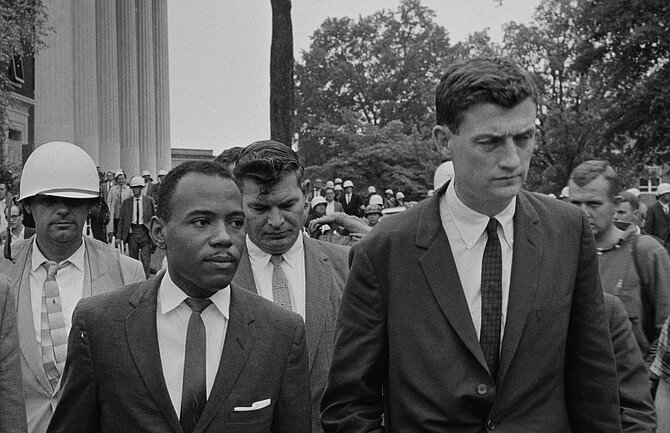 |
| James Meredith & John Doar |
Ross Barnett ended up double-crossing the White House. And his stalling tactics had allowed General Edwin Walker to build up an angry crowd estimated at anywhere from two to three thousand rabid segregationists, including Klansmen. On the Sunday evening of September 30th, Deputy Attorney General Nicolas Katzenbach headed the escort to prepare for Meredith's next day registration. Just before that was to occur, Barnett pulled the state troopers who were supposed to maintain order until Meredith was processed. (Bernstein, p. 83) A riot ensued and Walker’s crowd outnumbered the federal marshals. What made it worse was that Katzenbach’s communications network went down, and the troops that were supposed to arrive in a contingency failed to arrive when they were scheduled. Two bystanders were killed, scores of marshals were injured and 13 men were indicted. President Kennedy had marshals escort Meredith constantly until he graduated. (Brauer, pp. 195-97)
The next year, at the University of Alabama, things went smoother. This was part of perhaps the most groundbreaking three days any president has had since FDR. On June 9th, President Kennedy had made a strong speech for civil rights at a mayor’s conference in Hawaii. (Andrew Cohen, Two Days in June, pp. 18-19) Coming back from Hawaii, on June 10th, the president announced his plans for détente with the Russians in his speech at American University.
The next day, President Kennedy had his showdown with Governor George Wallace in Tuscaloosa. Robert Kennedy had tried to talk to Wallace in order to prevent anything like Ole Miss from happening. (Cohen, p. 235) Again, an associate of Frank Johnson, Judge Seybourn Lynne, had written the order for two African American students to enter the university. (Cohen, p. 236) Wallace had arranged for a combined force of 895 state troopers and police to back him. The White House brought in 3000 troops; this time they were only minutes away. (Cohen, pp. 243-47)
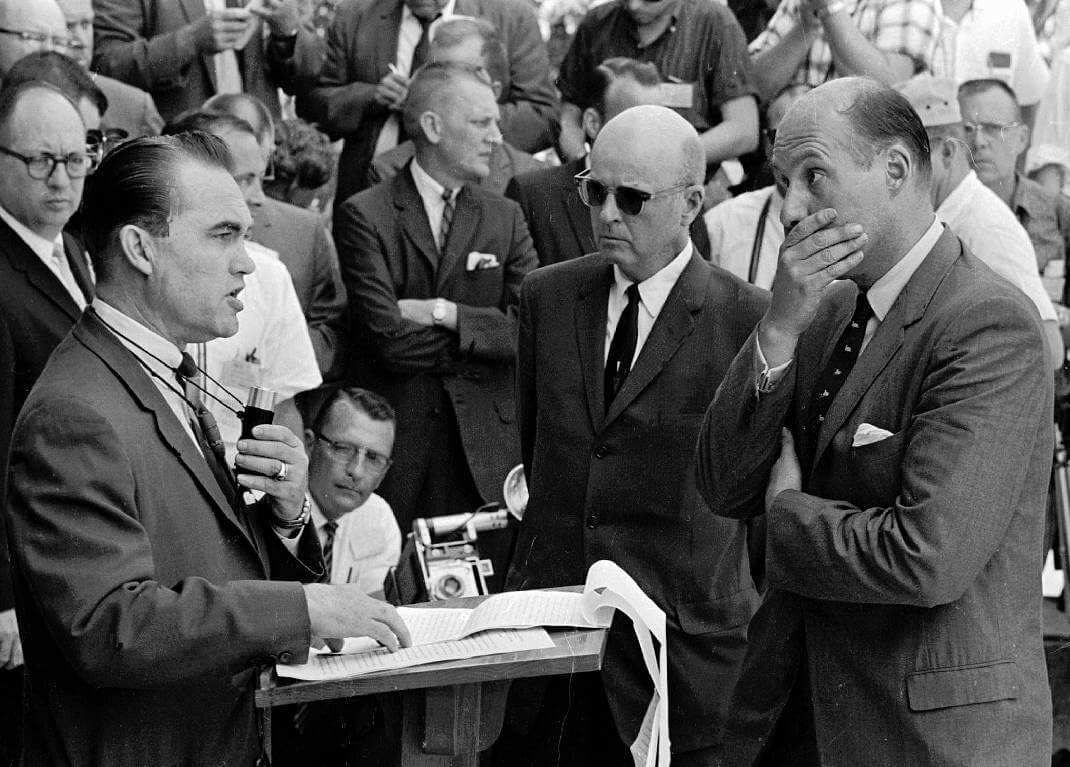 |
| Wallace confronted by Katzenbach |
Contrary to what MSM hacks like Evan Thomas claim, no one knew what Wallace was going to do that day. The proof of this is that in the documentary film made of this event, Robert Drew’s Crisis, Bobby Kennedy is suggesting that they may have to shove the students through the furthest door at the main entry. That discussion went on as Katzenbach was preparing to confront Wallace. Andrew Cohen, who has written one of the longest and most detailed studies of the event, agrees with that view. According to Cohen, the plan was only finalized that morning. (Cohen, pp. 247-49) When Wallace refused to leave, President Kennedy nationalized the state guard. General Henry Graham threatened to arrest Wallace, so he stepped aside. The other point that had an impact on Wallace’s decision was that Lynne had promised to cite Wallace for contempt if he obstructed the students’ entry. (Bernstein, p. 97)
That evening, President Kennedy gave what many believe was the finest speech given on the race issue since Abraham Lincoln. As Cohen writes, what makes that speech even more impressive is that it was written in two hours. (Cohen, p. 321) After King heard it, he told the person he was watching it with, Walter Fauntroy, “Walter, you believe that white man not only stepped up to the plate, he hit it over the fence.” (Cohen, p. 339)
But Wallace was not finished. On July 22, 1963, Judge Johnson signed an order for 13 African American students to attend Tuskegee High School in Macon County, Alabama. In addition, the same would happen in Mobile and Birmingham. (Sikora, chapter 22) On the day those 13 students were supposed to be in attendance, there was a large force of state troopers awaiting them. Wallace also sent an order to the superintendent that the school would not open.
Bobby Kennedy now convened a five-man panel of the Fifth Circuit to issue a restraining order enjoining Wallace from interfering with the integration of the three schools. Wallace tried to get around that by now sending the National Guard in to stop the students from entering. That afternoon President Kennedy ordered the guard to be nationalized, that is, placed under his control. (Sikora, chapter 23)
VI
At the end of 1962, President Kennedy issued his executive order to integrate housing. It inserted nondiscrimination clauses for all new public housing developments and urban renewal projects, and took action against housing contractors who practiced discrimination. Because it was an executive order, its scope was limited. (Brauer, p. 210) This relates to a criticism made by several writers, such as King biographer Taylor Branch, and which Levingston continues. (pp. 205-06, 213, 226) King wanted Kennedy to issue an executive order in 1963 as a new Emancipation Proclamation to strike down segregation in the South. Kennedy did not and writers like Branch and Levingston imply that this was some kind of missed opportunity that King offered the president.
This author decided to get into contact with the Dean of the law school at Cal Berkeley, Professor Erwin Chemerinsky. I queried him, since he is one of America’s most illustrious constitutional scholars and has a liberal reputation. He replied that if Kennedy had done that, it would have only applied to the executive branch of government, not to private businesses and not even to state and local governments. (email communication, October 15, 2018) Since, as we have seen, Kennedy was already integrating the executive branch by other means, the Levingston/Branch implication is baseless.
As noted previously, President Kennedy submitted a civil rights bill to Congress on February 28, 1963. (Risen, p. 36) He accompanied this with an address. That address, like other statements he had made on the subject—going all the way back to when he was a senator, and during the 1960 campaign—had a moral dimension to it. Which counters the idea of playwright Levingston: that JFK only understood the moral dimension in his June 1963 televised address. (Levingston, p. 405) The February bill was significantly revised as the year went on due to media pressures which finally made civil rights a continuing front page/TV news lead story.
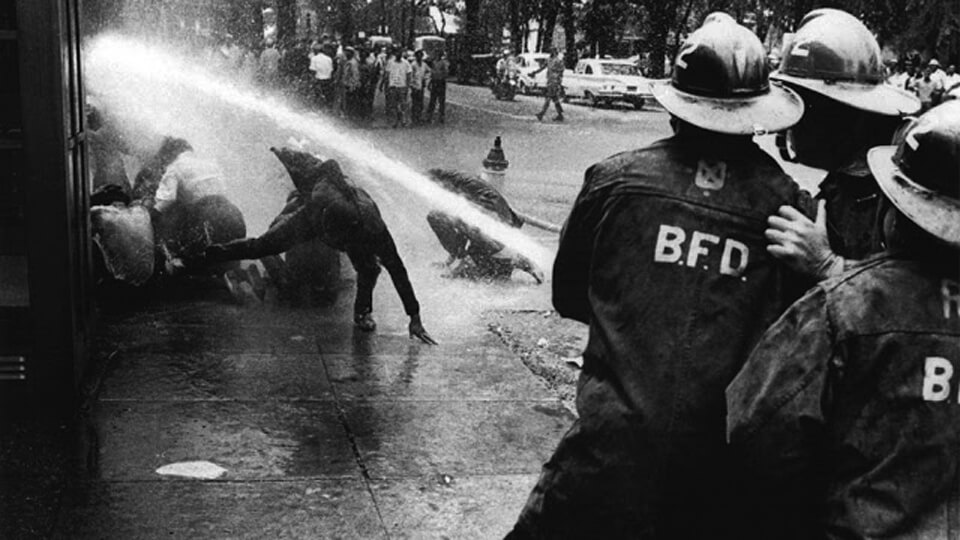 |
| Birmingham, May 1963 |
As the conflict in Birmingham took hold and the media began to report on it, the opportunity presented itself to make the bill even stronger. The masterstroke at Birmingham was using schoolchildren in illegal demonstrations, knowing that Bull Connor would overreact. Which he did, using powerful fire hoses and attack dogs. It was those newspaper and TV images that altered the consciousness of this issue in the north. It also made John Kennedy understand the sick pathology of many of the power brokers in the South, and that he had been wrong in his characterization of Thaddeus Stevens in Profiles in Courage. (Brauer, p. 240)
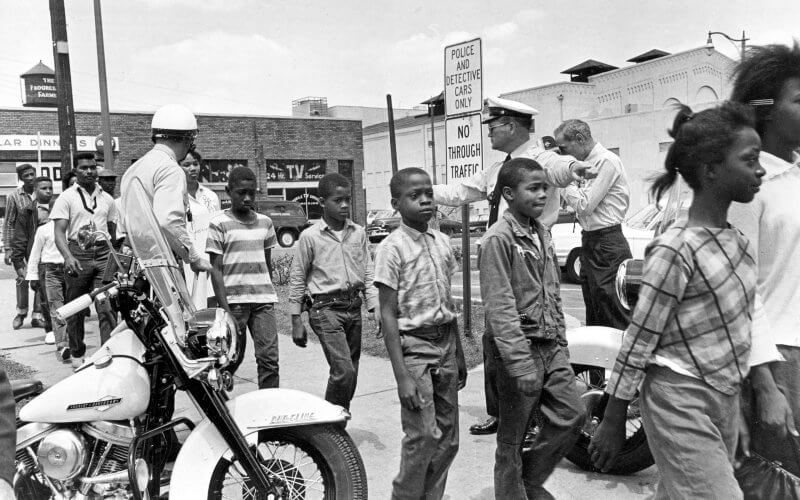 |
| It was James Bevel who organized Birmingham school children |
That maneuver was not proposed or executed by King. In fact, at this point, on his own, King could not get enough demonstrators in the streets. It was James Bevel who went on local radio and gathered scores of school kids in a church on April 24th, a move that King actually opposed at the time. (McWhorter, p. 361) Then, with King out of town, Bevel began to work with and organize the students. He told them to listen to a secret code word he would use on the radio. And on May 2nd, with King still mulling the idea over, Bevel launched his first student wave. Six hundred kids went to jail. But Bevel continued it a second day, with even more students involved. (McWhorter, pp. 368-71) The ugly media exposure was a body blow to the power structure in Birmingham. Vincent Townsend, CEO of the local newspaper, got someone in the sheriff’s office to call Burke Marshall. He flew down and that was the beginning of the city-wide settlement. (McWhorter, pp. 380-81)
Both the president and Bobby Kennedy now realized that this was the time to stamp out Jim Crow in the South. In 2003, in an interview with Dick Gregory on the Joe Madison show, he said that President Kennedy had called him after he had visited Birmingham. After Gregory described just how bad it was, Kennedy replied: “We got those bastards now!” Consequently, the February bill was overhauled by the Justice Department to focus on public accommodations. (Risen, pp. 45-49) Once that was decided, the president now began an unprecedented, massive lobbying effort. He brought to Washington dozens of groups of people: lawyers, mayors, governors, business leaders and, most important of all, the clergy. This effort lasted from May 29 through June 22nd: in other words, right up until when the bill was presented to Congress. (Risen, p. 63) From those meetings, which were attended by 1,558 persons, spin-off groups back home were created. And those groups now traveled to Washington to lobby Congress during the long debate on the bill. Senator Richard Russell later noted it was this impact that won in the end. What JFK had done was something King could not do. He got a wide array of church leaders to back his bill. (Risen, pp. 96-97, 148-49) As Russell put it, “We had been able to hold the line until all the churches joined the civil rights lobby in 1964.” (Risen, p. 5) As Risen notes, King had little or nothing to do with the passage of the bill. (pp. 83-84)
The even bigger myth is that it was LBJ who got the bill passed. This was a deception first advanced by Kay Graham and the Washington Post in order to aggrandize her friend and mentor President Johnson. It was then furthered by Robert Caro in The Passage of Power. Caro pretty much followed what his subject Johnson had written. (The New Republic, “The Shrinking of Lyndon Johnson”, February 9, 2014) The people who really got the bill passed were Hubert Humphrey, Bobby Kennedy and his Justice Department team, and Senator Thomas Kuchel. This is why RFK did not resign as attorney general until the bill was passed.
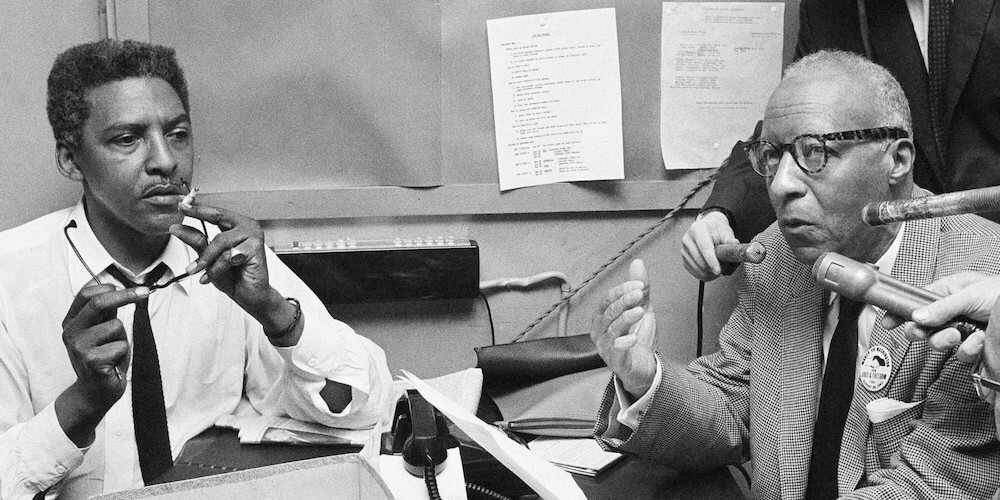 |
| Bayard Rustin & Philip Randolph |
King made a charge at this time that was simply wrong. He said that President Kennedy wanted to call off the proposed March on Washington. (Risen, p. 83) Levingston’s lousy book takes a little lighter approach and tries to insinuate that JFK had nothing to do with the march. (Levingston, p. 423) First, as several books have pointed out, the March on Washington was not King’s idea or a product of the SCLC. It was the proposal of Philip Randolph and Bayard Rustin. (Charles Euchner, Nobody Turn Me Around, pp. 17-18; Patrick Henry Bass, Like a Might Stream, p. 107; Bernstein, pp. 112-13) It was meant as a fulfillment of what Randolph had negotiated away to FDR and Truman. Kennedy was not opposed to the idea. He was opposed to the first draft design. Rustin’s concept was to have a two-day mass demonstration aimed at Capitol Hill. Arthur Schlesinger was at the early meetings where it was presented to President Kennedy. (Schlesinger, A Thousand Days, pp. 969-972) Kennedy’s objection was that this was the wrong approach, it was too confrontational. Both Whitney Young and Roy Wilkins agreed with JFK. (Euchner, p. 77) So after the president got some of his own people on the organizing committee, like Walter Reuther, it was scaled back to a one-day event, and centered in front of the Lincoln Memorial. Rustin insisted he could live with these revisions since the important factors were the size of the live audience and the scope of the televised audience. (Euchner, pp. 77-78) Once that was done, President Kennedy became the first white politician in Washington to endorse the march. He then had his brother Robert assign men from the Justice Department to assist with the logistics and to arrange security. It is doubtful that the event could have come off as well as it did without that help. (Bernstein, pp. 114-16)
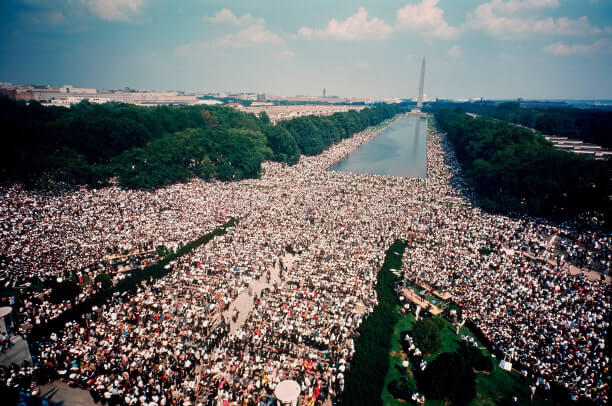 |
| The March on Washington |
One last point on this event. Some have questioned why President Kennedy did not speak that day. The answer is simple: the principal organizer, Bayard Rustin, did not want him there. Not because he did not like Kennedy—he did. But because he thought it would detract from it being their moment, that is, the civil rights leaders’ time in the sun. So he and Wilkins made up an excuse that his life would be endangered, and they would see him afterwards instead. (Euchner, pp. 79-80)
Kennedy realized his presidency was on the line with the civil rights bill. He had now become hated in the South. The joke after his showdown with Wallace was: Why does Alabama have so many Negroes and Massachusetts so many Kennedys? Because Alabama had first choice. (McWhorter, p. 380) By June of 1963, his approval rating there had plummeted from 60 to 33%. He was losing votes on his other programs because of his stand for civil rights. But as Kennedy told Luther Hodges, “There comes a time when a man has to take a stand and history will record that he has to meet these tough situations and ultimately make a decision.” (Brauer, pp. 247, 263-64)
When the bill first went up, Humphrey had 42 votes, well short of the 67 he needed to force a cloture on the filibuster. (Brauer, p. 269) It was the full court press done by the president and then by the Department of Justice that finally turned it around through pressure on conservative Midwest Republicans. (Risen, p. 97) It is hard to exaggerate the impact of this bill. “It reached deep into the social fabric of the nation to refashion structures of racial order and domination that had held for almost a century—and it worked.” (Risen, p. 12)
As the reader can see, no president before Kennedy ever confronted the civil rights issue as he did. No one was even close. It was the preceding century of near inertia that created the immense problem that President Kennedy faced in 1961. But to his credit, Kennedy pressed the issue from the outset. Finally, the pressure from his administration, and the inspiration and support he gave the civil rights movement, provided the opportunity to pass what Clay Risen has called the “bill of the century”. What JFK achieved in three years is remarkable, especially when compared to his predecessors. As historian Carl Brauer wrote, what President Kennedy did was to pick up the narrow trail that Truman attempted and widen it into broad avenues. (Brauer, p. 315) And those avenues are still being traversed today. Yesterday (November 2, 2018), Kristen Clarke, the president of the Committee for Civil Rights Under Law, announced a victory for the Democrats in Georgia. Agreeing with Clarke, the court made a ruling weakening the state's attempt to limit voting among the poor and minority groups. Clarke's activist committee was founded in 1963 by President Kennedy for the express purpose of counteracting attempts at discrimination in the Deep South. (On the list of achievements following this essay, the reader can see it at number 20.)
When the news of President Kennedy’s assassination reached Atlanta, King grew very quiet, thinking that a similar fate awaited him. During the funeral his six-year-old son asked him, “Daddy, President Kennedy was your best friend wasn’t he?” Coretta King replied, “In a way, he was.” (Wofford, p. 175)
Four Presidents: A Comparison of Civil Rights Actions and Achievements
FDR (13 years in office) | TRUMAN (7 years in office) | EISENHOWER (8 years in office) | KENNEDY (3 years in office) | |
1 | Fair Employment Practices in Defense Plants (FEPC) | Integrated the Military | Sent troops to Little Rock in 1957 | Orally committed to backing the Brown decision |
2 | Appointed African Americans as policy advisors | Tried to pass a civil rights bill | Established Civil Rights Commission | Indicted school officials who defied court orders on Brown |
3 | Made speeches on civil rights in 1952 | Created a Free Schools district when Virginia decided to drop public education | ||
4 | First administration to join civil rights cases as a plaintiff, not a friend of the court | |||
5 | Petitioned the ICC to integrate interstate busing and terminals | |||
6 | Systematically began to file cases to break down denial of voting rights in the South | |||
7 | Financed voter registration drives in the South | |||
8 | Began the drive to ban poll taxes with the 24th amendment | |||
9 | Started a massive and rigorous affirmative action program in all branches of federal government | |||
10 | Announced that no member of his administration would join a segregated establishment or speak at a segregated event | |||
11 | Revived FDR’s FEPC with the CEEO | |||
12 | Established rigorous contract and grant requirements to integrate private colleges in the South | |||
13 | Established a program to make federal contractors follow non-discriminatory hiring practices | |||
14 | Carried out court orders to integrate the last public universities in the South | |||
15 | Exploiting an exception to the law, sent in federal marshals and troops to Oxford, Mississippi and to Alabama during the Freedom Rides | |||
16 | Signed the Housing Act of 1962 | |||
17 | Negotiated a settlement to the Birmingham demonstration in 1963 | |||
18 | Endorsed the March on Washington in 1963 | |||
19 | In a nationally televised address of 6/11/63, made the most forceful presidential address on civil rights since Lincoln | |||
20 | Established the Lawyers’ Committee for Civil Rights in 1963 to represent victims of civil rights abuses in the South | |||
21 | Submitted the epochal Civil Rights Act of 1964 and began a massive lobbying program to pass it |
So much for the received wisdom that the Kennedy administration “moved cautiously on civil rights” until they were pushed into it.


